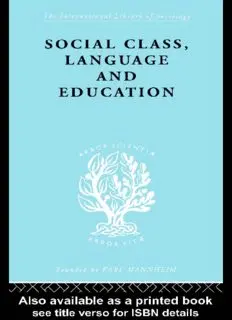
Social Class, Language and Education: International Library of Sociology I: Class, Race and Social Structure (International Library of Sociology) PDF
Preview Social Class, Language and Education: International Library of Sociology I: Class, Race and Social Structure (International Library of Sociology)
T h e I n t e r n a t i o n a l L i b r a r y o f S o c i o l o g y SOCIAL CLASS, LANGUAGE AND EDUCATION F o u n d e d b y K A R L M A N N H E I M T h e I n t e r n a t i o n a l L i b r a r y o f S o c i o l o g y RACE, CLASS AND SOCIAL STRUCTURE In 21 Volumes I The Changing Social Structure in England and Wales Marsh II Class in American Society Reissman III Class Structure in the Social Consciousness Ossowski IV Co-operative Communities at Work Infield V Co-operative Living in Palestine Infield VI Colour and Culture in South Africa Patterson VII The Deprived and the Privileged Spinley VIII The First Years of Yangyi Commune Crook IX The Functions of Social Conflict Coser X The Home and Social Status Chapman XI The Marginal Situation Dickie-Clark XII Negroes in Britain Little XIII Neighbours Bracey XIV The People of Ship Street Kerr XV Social Class, Language and Education Lawton XVI Social Mobility in Britain Glass XVII The Sociology of Colonies - Part One Maunier XVIII The Sociology of Colonies - Part Two Maunier XIX Stevenage Orlans XX Studies in Class Structure Cole XXI Working Class Community Jackson SOCIAL CLASS, LANGUAGE AND EDUCATION by DENIS LAWTON First published in 1968 by Routledge and Kegan Paul Ltd This edition published in the Taylor & Francis e-Library, 2001. © 1968 Denis Lawton All rights reserved. No part of this book may be reprinted or reproduced or utilized in any form or by any electronic, mechanical, or other means, now known or hereafter invented, including photocopying and recording, or in any information storage or retrieval system, without permission in writing from the publishers. The publishers have made every effort to contact authors/copyright holders of the works reprinted in The International Library of Sociology. This has not been possible in every case, however, and we would welcome correspondence from those individuals/companies we have been unable to trace. British Library Cataloguing in Publication Data A CIP catalogue record for this book is available from the British Library Social Class, Language and Education ISBN 0-415-17633-6 (Print Edition) Class, Race and Social Structure: 21 Volumes ISBN 0-415-17826-6 (Print Edition) The International Library of Sociology: 274 Volumes ISBN 0-415-17838-X (Print Edition) ISBN 0-203-00129-X Master e-book ISBN ISBN 0-203-17529-8 (Glassbook Format) CONTENTS PREFACE AND ACKNOWLEDGEMENTS page vii LIST OF TABLES ix I Social Class and Educational Opportunity: the demographic evidence 1 II Motivation, Sub-culture and Educability 7 III Empirical Evidence on the Relation between Language and Social Background 20 IV Language and Thought 38 V A Critique of Bernstein’s Work on Language and Social Class 77 VI An Experimental Study of the Speech and Writing of some Middle- and Working-class Boys 103 VII Some Proposed Intervention Programmes in the U.S.A. and Great Britain 144 VIII Conclusion 156 BIBLIOGRAPHY 162 INDEX 175 v PREFACE AND ACKNOWLEDGEMENTS I first became interested in the question of language and social class at my first teaching post in a secondary school. I was teaching English, and it soon became very noticeable that many of the pupils labelled as ‘diffi- cult’, or even ‘ineducable’ (although they were in the top 12 per cent of the population as regards intelligence) and who were grouped together in the bottom stream of the third or fourth year had in common not a lack of intelligence but certain social attitudes and linguistic difficulties. I found that my work as a teacher was illuminated by the study of sociology, and in particular by the research of Basil Bernstein. This book is an attempt to analyse the educational implications of language and social class from a theoretical point of view, and also to make some practical suggestions for the attention of educationists. I feel very strongly that this is an area where any attempts to ‘reform’ teaching methods and curriculum should be based on sound theoretical principles. I should like to express my thanks to a number of colleagues at the London Institute of Education who have discussed certain aspects of this book with me, and made helpful suggestions: I am particularly grate- ful to Miss Nancy Martin and Professor Basil Bernstein for letting me take up much more of their time than I could reasonably expect. I must also thank the Headmasters of the two schools mentioned in Chapter VI, and also the pupils at those schools who uncomplainingly took part in the experiment. Finally, I am very grateful to Miss Sophie Bowlby who for several months generously acted as unpaid research assistant, and to my wife who has typed and re-typed, read and re-read the many drafts of this book with only an occasional murmur of complaint. DENIS LAWTON vii LIST OF TABLES 1. Social Origins of Boys Entering Secondary Grammar Schools Before and After 1944. England and Wales page 2 2. Percentage of Children at maintained Grammar Schools achieving 5 or more ‘O’ levels. England and Wales 5 3. Analysis of Sentence Length of Hearing Children. Heider and Heider (1940) 22 4. Open-ended Sentence Completion Test 116 5. Ego-centric: Socio-centric Sequences 118 6. Content Analysis: Percentage of Utterances falling into each of four Categories 122 7. Comparison with Bernstein’s Results 125 8. Discussion: Linguistic Measures 132 ix
